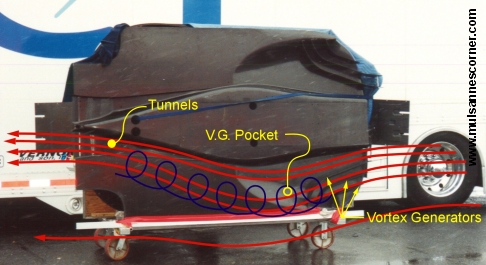turbof1 wrote: ↑02 May 2017, 19:02
f1316 wrote: ↑02 May 2017, 18:40
turbof1 wrote: ↑02 May 2017, 12:57
The thing is, the rear wing has only been widened and sits lower. It's not creating a lot more downforce & turbulence, and indeed percentage-wise compared to the whole car it has dropped. On top of that, many to most teams now run smaller rear wings then is required by the regulations. Before this year, teams ran at almost every venue the max allowed dimensions. This is now no longer needed as overall downforce has increased enough.
So that means, in my opinion, most of the increased turbulence comes from the diffuser. A lot of people are pointing towards more ground effect to solve the overtaking issue, which in my eyes is nothing more than a myth and proved by this year's rules. I was hopeful that this year's rules would allow for a better upwash of the turbulent airflow coming out of the diffuser as the rear wing sits lower and should better connect the flows. However, the smaller wing and the hung back position means that although the flows definitely should connect better, the angle of the flow is way less swept up. Ben already warned about this a few months ago and although I was skeptical about it, he now looks set to be right about it.
I think a higher rear wing and a beam wing actually might aid overtaking.
Not trying to be a smart arse, but didn't we have those things in 2010 with very little overtaking? Or am I missing something?
Double diffuser.
I'm not claiming this would be a solve all miracle, for the record. There has to be more study and testing into what is effectively unknown territory.
Hmmmm it's tough to know, isn't it, because in all subsequent years prior to hybrid era we had a high rear wing + beam wing and no double diffuser - and yes, there was a lot more overtaking.
But my impression over those years was not that cars had no trouble with dirty air but that the differences in grip because of flimsy Pirelli tyres (+drs and, let's not forget, driver controlled KERS) were the things allowing them to overcome it.
You may be right, it may be better this way - and certainly any images I've seen attempting to illustrate the wake of a car show large vortices coming off the diffuser, so seems likely that ground effect is not the answer, unless the air coming off the diffuser is somehow treated differently (tunnels that feed smaller volume diffuser perhaps?) - but equally beam wings and high rear wings have been done without being the 'answer' (as indeed you say). High rear wings are imo not very nice aesthetically.
FYI I'm actually not too bothered by overtaking being very hard; i do think a manually controlled kers was nice since both drivers had it, so it was less artificial than drs, but it gave them a strategic tool.



